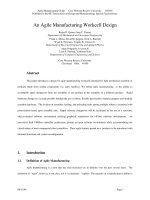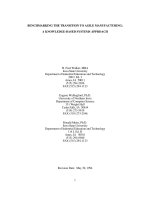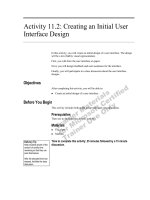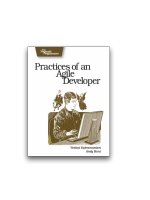An agile manufacturing workcell design
Bạn đang xem bản rút gọn của tài liệu. Xem và tải ngay bản đầy đủ của tài liệu tại đây (248.57 KB, 17 trang )
Agile Manufacturing Group Case Western Reserve University 10/4/95
Published in the IIE Transactions on Design and Manufacturing, Special Focused Issue
06/11/96 Page 1
An Agile Manufacturing Workcell Design
Roger D. Quinn, Greg C. Causey
Department of Mechanical and Aerospace Engineering
Frank L. Merat, David M. Sargent, Nick A. Barendt
Wyatt S. Newman, Virgilio B. Velasco Jr.
Department of Electrical Engineering and Applied Physics
Andy Podgurski, Ju-yeon Jo
Leon S. Sterling, Yoohwan Kim
Department of Computer Engineering and Science
Case Western Reserve University
Cleveland Ohio, 44106
Abstract
This paper introduces a design for agile manufacturing workcells intended for light mechanical assembly of
products made from similar components (i.e. parts families). We define agile manufacturing as the ability to
accomplish rapid changeover from the assembly of one product to the assembly of a different product. Rapid
hardware changeover is made possible through the use of robots, flexible part feeders, modular grippers and modular
assembly hardware. The division of assembly, feeding, and unloading tasks among multiple robots is examined with
prioritization based upon assembly time. Rapid software changeover will be facilitated by the use of a real-time,
object-oriented software environment utilizing graphical simulations for off-line software development. An
innovative dual VMEbus controller architecture permits an open software environment while accommodating the
closed nature of most commercial robot controllers. These agile features permit new products to be introduced with
minimal downtime and system reconfiguration.
1. Introduction
1.1 Definition of Agile Manufacturing
Agile manufacturing is a term that has seen increased use in industry over the past several years. The
definition of “agile”, however, is not clear, nor is it consistent: “Agility: The measure of a manufacturer's ability to
Agile Manufacturing Group Case Western Reserve University 10/4/95
Published in the IIE Transactions on Design and Manufacturing, Special Focused Issue
06/11/96 Page 2
react to sudden, unpredictable change in customer demand for its products and services and make a profit”
1
. “Today
factories are coming on line that are agile at tailoring goods to a customers requirements, without halting
production...”
2
. “Agile manufacturing assimilates the full range of flexible production technologies, along with the
lessons learned from total quality management, ‘just-in-time’ production and ‘lean’ production”
3
. The only common
thread among the various definitions is the ability to manufacture a variety of similar products based on what may
be rapidly changing customer needs.
Figure 1: Agile Workcell
A definition of “agile” manufacturing has been adopted which applies to light mechanical assembly of
products made from components in parts families: Agile manufacturing is the ability to accomplish rapid
changeover between the manufacture of different assemblies. Rapid changeover, further, is defined as the ability to
move from the assembly of one product to the assembly of a similar product with a minimum of change in tooling
and software. A corollary of this definition of agility is that agile manufacturing should also allow for the rapid
introduction of new parts. Agility in manufacturing opposes the prevailing mass production, Fordist
4
, paradigm,
characterized by the methods championed by Henry Ford: high volume production of low cost, standardized
products. This contemporary paradigm shift is motivated by the ever increasing competition seen in all industries
and by a more demanding customer base.
Agile Manufacturing Group Case Western Reserve University 10/4/95
Published in the IIE Transactions on Design and Manufacturing, Special Focused Issue
06/11/96 Page 3
Rapid changeover enables the production of small lot sizes, allowing for ‘just-in-time’ production. This is
accomplished through the use of robust, reusable software; quick change grippers for the robotic manipulators; and
parts feeders which are flexible enough to handle several types of parts without needing mechanical adjustment.
These feeders use vision, in place of hard fixturing, to determine the position and orientation of parts. Generic,
reusable pose estimation vision routines permit new parts to be added to the system with a minimum of effort.
A testbed implementation of an agile manufacturing workcell has been developed (Figure 1). Which
includes mechanical manipulators, flexible part feeders, a vision system (cameras, frame grabber, and a library of
image processing routines), as well as a limited number of dedicated sensors and actuators. A workcell controller
integrates and synchronizes the operating of the individual components.
1.2 Scope and Importance of CWRU Work
Several companies have implemented what may be considered “agile” manufacturing. For example,
Motorola has developed an automated factory with the ability to produce physically different pagers on the same
production line
5
. At Panasonic, a combination of flexible manufacturing and just-in-time processing is being used to
manufacture bicycles from combinations of a group of core parts
6
. Against the backdrop of such work, the CWRU
workcell is innovative in several ways. The use of vision-guided, flexible parts feeders is one example. Another is
the object oriented design of the software. The over-arching design philosophy of quick-changeover, however, is
what makes this workcell particularly novel. The CWRU workcell has been designed to be a versatile production
facility, amenable to a wide range of light manufacturing applications.
2. Workcell Hardware
The agile workcell developed at CWRU consists of a Bosch flexible automation system, multiple Adept
SCARA robots, as many as four flexible part feeders per robot, and an Adept MV controller with an AdeptVision
System. The robots are mounted on pedestals near the conveyor system. Pallets with specialized parts fixtures carry
assemblies throughout the system. Finished assemblies are removed from the pallets by an unloading robot. A safety
Agile Manufacturing Group Case Western Reserve University 10/4/95
Published in the IIE Transactions on Design and Manufacturing, Special Focused Issue
06/11/96 Page 4
cage encloses the entire workcell, serving to protect the operator as well as providing a structure for mounting
overhead cameras.
Figure 2: Overhead View of a Workstation
2.1 Conveyor System
The conveyor system used in the CWRU workcell is a Bosch model T2. Pallets are circulated on two main
conveyor sections. These sections are straight and parallel to each other, operating in opposite directions. Pallets are
transferred between these two sections by means of Lift Transfer Units (LTU’s). These allow for the circulation of
pallets around the conveyor system and the capability to “shuffle” or re-order the pallets.
Each of the pallets in the system has a unique identification number, allowing the system to track and direct
their progress. Stops are mounted at critical points on the conveyor to control the flow of the pallets.
An innovative design feature is the short “spur line.” A spur line(Figure 3) is simply an extension of the
conveyor, perpendicular to the main line (analogous to a railroad spur) which is used to remove pallets needed at an
assembly station from the main conveyor. This allows the flow of the main conveyor line to be maintained while a
Agile Manufacturing Group Case Western Reserve University 10/4/95
Published in the IIE Transactions on Design and Manufacturing, Special Focused Issue
06/11/96 Page 5
robot performs an assembly at the spur. Due to space constraints, optical proximity sensors are used to detect the
presence of a pallet on a transfer station instead of the standard rocker and inductive proximity sensors.
2.2 Assembly Stations
Each assembly robot is surrounded by two modular, removable work tables and two fixed feeding tables.
(Figure 2). The modular tables are easily exchangeable, allowing for specialized assembly hardware to be placed
within the robot’s work envelope (Figure 3), and contain pneumatic actuators and electrical sensors with quick-
connectors allowing for the rapid change of any specialized tooling required for a given assembly. As part of the
rapid changeover procedure, the modular work tables are registered in the robot’s world coordinate system by an
arm-mounted camera. The feeding tables are fixed, and the horizontal parts-feeding conveyors are mounted to them.
Figure 3: Workstation Layout
Agile Manufacturing Group Case Western Reserve University 10/4/95
Published in the IIE Transactions on Design and Manufacturing, Special Focused Issue
06/11/96 Page 6
One drawback of the conveyor/spur system is the time required to exchange a full pallet for an empty one
(approximately 15 seconds). During this time the robot would conceivably be inactive. An elegant solution to this
problem is a mini-warehouse: a fixture is located on the modular portion of the work table to hold a few completed
assemblies. During a pallet swap, the robot can continue the assembly operation, placing the completed assemblies
in the mini-warehouse, while the incoming pallet arrives. After the incoming pallet is transferred to the spur, the
vision system registers the pallet in the same manner as the modular work tables (i.e. an arm-mounted camera). The
robot then places the current assembly (still in its gripper) on the pallet and then proceeds to move the completed
assemblies from the mini-warehouse to the pallet.
Several workcell layouts were examined varying in their placement of the robot relative to the spur (and
thereby the pallet). The first layout examined, shown in Figure 3, places the robot facing the spur with the pallet
centered in its work envelope. The parts feeders enter the work envelope of the robot from the rear on both sides.
The second layout examined (Figure 4) placed the robot next to the spur, with the robot facing away from the main
line of the conveyor. The pallet was located to the right side of the robot’s work envelope with the feeders located to
the front and left side of the robot. The final layout examined (Figure 5) placed the robot in front of the spur (as in
the first layout) but rotated by 90
0
. The pallet would be located on the right side of the work envelope, the feeders
would be placed to the left side of the work envelope, while the assembly area would be directly in front of the robot.
Figure 4: Layout Concept 2
Agile Manufacturing Group Case Western Reserve University 10/4/95
Published in the IIE Transactions on Design and Manufacturing, Special Focused Issue
06/11/96 Page 7
Figure 5: Layout Concept 3
After evaluating several features of each option, including placement of the robots relative to the conveyor,
orientation of the robots, impact of feeder placement relative to the robot work envelope, and the robot motions
necessary for a generic assembly given a particular envelope layout, it was determined that the first layout would best
suit our needs. This layout yielded the best use of the robot’s work envelope while also reducing the amount of
motion for a generic assembly. We define a “generic assembly” as a series of movements between various parts
feeder locations, assembly locations, and pallet locations that would typify an assembly task.
2.3 Assembly Procedure
Currently, we are testing the system using a small assembly consisting of four plastic components. In our
case, the first component, Part A, is used as the base to which the other three components are attached. Part B is
snapped onto the exterior of the base component. The A/B subassembly must then be inverted. The last two
components, Part C and Part D, are inserted into the bottom of this sub-assembly, with a special guide being used to
insert the last component. This process typifies the type of “light” assembly tasks for which our workcell was
developed .
Agile Manufacturing Group Case Western Reserve University 10/4/95
Published in the IIE Transactions on Design and Manufacturing, Special Focused Issue
06/11/96 Page 8
Figure 6: Example Assembly
Several concepts were generated for the assembly procedure. For this assembly, consisting of only four
parts, we assumed that no more than two robots would be used. One factor examined was the division of labor. For
example, in Case 1, each robot could perform an entire assembly task or, in the Case 2, the robots could each
perform part of the task. We also examined a third case in which one robot would be dedicated to parts feeding and
another robot would be dedicated to assembly.
Examining the example assembly, a natural division of labor would be to split the job in half: one robot
could attach Part B to Part A, then a second robot would take this sub-assembly and insert Parts C and D. To test this
concept, we programmed an Adept SCARA robot to emulate the motions necessary for an assembly. For Case 1, the
time required for each assembly move was recorded, and the time required for gripper changes was estimated. Since
four parts were to be manipulated in Case 1, a gripper change was necessitated. For Case 2, the assembly was
simulated as two separate subassembly tasks and the larger of the two sub-assemblies times was used as the assembly
cycle time (i.e. the time between assembly outputs). In this case, no tool change was required as each robot only
handled two parts. Two grippers on a single rotary wrist (Figure 7) let the robot handle the two parts without a
gripper change. We found that two robots working in tandem could produce a part every 10 seconds, and that two
robots working independently could produce a part every 18 seconds. The latter time results mainly from a tool
change and from the added motion required to traverse the robot’s work envelope. Thus, lower cycle times can be
achieved using two robots working in tandem.
Agile Manufacturing Group Case Western Reserve University 10/4/95
Published in the IIE Transactions on Design and Manufacturing, Special Focused Issue
06/11/96 Page 9
Figure 7: Multiple Grippers on a Rotary Wrist
A third case, wherein one robot would be used for parts feeding and another would be dedicated to
assembly, was also examined. However, this approach was rejected because space constraints on the pallet fixtures
would limit throughput and increase cycle times.
2.4 Flexible Parts Feeders
Each feeder consists of three conveyors (Figure 8). The first conveyor is inclined and lifts parts from a
bulk hopper. The second conveyor is horizontal and transports the parts to the robot. An underlit translucent
conveyor belt presents part silhouettes to the robot’s vision system which then selects parts which are suitably
oriented for pick up. An array of compact fluorescent lights is installed within each of the horizontal conveyors to
provide a lit background on which the parts produce a clean, binary image. The third conveyor returns unused or
unfavorably oriented parts to the bulk hopper. Proper functioning of the feeders depends on the parts being lifted
from the bulk hopper in a quasi-singulated manner. Many factors influence the effectiveness of the inclined
conveyor; i.e., the angle of the conveyor with respect to the horizontal, the belt properties (e.g. coefficient of
friction), the type of belt (cleated, magnetic, vacuum), and the linear speed of the belt.
Agile Manufacturing Group Case Western Reserve University 10/4/95
Published in the IIE Transactions on Design and Manufacturing, Special Focused Issue
06/11/96 Page 10
Figure 8: Flexible Parts Feeding System Schematic
When the feeder is to be used for a different part (i.e. a changeover) the bulk hopper is emptied and filled
with the new part. If the parts are of a similar geometry, no changes to the feeding system are typically needed.
Some parts, such as circular or cylindrical ones (i.e. ones that would roll back down the incline) may require a
different belt surface (e.g. one with cleats) or a different angle of inclination for the inclined conveyor.
2.5 Vision System
One essential function of the vision system is to determine the position and orientation (pose) of parts in the
flexible parts feeders, eliminating the need for conventional mechanical feeders (e.g. bowl feeders). Pose estimation
is performed using built-in functions of the AdeptVision software, and must be fast enough not to degrade the
assembly cycle-time. Parts on the feeder belts are examined, using binary vision tools. First, the vision system
determines if a part is graspable (i.e. the part is in a recognized, stable pose and enough clearance exists between the
part and its neighbors to grasp it). Second, the pose of the part in the robot’s world coordinates is determined. This
pose, and the motions associated with acquiring the part, are checked to make sure that they are entirely within the
work envelope of the robot. A secondary function of the vision system is to register pallets and modular work tables
to a robot’s world coordinate system, avoiding the need for alignment hardware and facilitating rapid changeover.
Although not a part of our current work, we plan to use vision for error recovery, wherein the cameras can be used
to inspect critical points in the system, or assemblies in-process.
Agile Manufacturing Group Case Western Reserve University 10/4/95
Published in the IIE Transactions on Design and Manufacturing, Special Focused Issue
06/11/96 Page 11
The vision processing is currently performed on an AdeptVision processor. The vision system uses eight
standard CCD cameras, mounted above the flexible parts feeders and the robot arms. Since the number of camera
inputs to the Adept Vision system is limited to four, a low-cost, custom video multiplexer was developed, utilizing a
monolithic MAXIM441 video-switcher which allows up to four cameras to be attached to each video system input.
The AdeptVision System can process only one image at a time. Any conflict between multiple vision
operations causes image corruption, so a vision scheduler which is responsible for all vision operations was
developed. In order to best utilize the AdeptVision resources, requests for vision processing are queued by the
vision scheduler using a multi-scan queuing mechanism. The scheduler inspects the request queue whenever the
vision processor becomes available. If multiple requests are queued, the vision scheduler selects the most critical
one for service. For example,
let Q denote the request queue and let the “critical robot” be the one which has the longest
estimated time to completion for its current assembly. The vision scheduler examines the request
queue in the following manner:
If Q contains only one entry, service it immediately
Q is inspected in the following order, with requests from the “critical robot” receiving priority:
1) Pallet/Worktable Registration Requests
2) Locate Next Part for Assembly Requests
3) Other Requests
If a vision operation fails, it is retried. After the maximum number of retries has been reached, the request is re-
queued as a request from a “non-critical robot,” lowering its priority, and allowing other requests to serviced.
In keeping with the quick-changeover philosophy, the vision routines are designed to be reusable; that is a
given routine may be used to locate several different but similar parts (i.e. similar symmetries/asymmetries, topology,
etc.). This approach has many advantages, including minimizing the number of software routines. In addition, this
reusability allows for software modularity and “agility
7
.” For example, by parameterizing the features that a routine
searches for, a software vision recognition routine can be applied to parts that have a similar profile but are of a
different size. This means that parts with geometries similar to those already in the software library can be added to
Agile Manufacturing Group Case Western Reserve University 10/4/95
Published in the IIE Transactions on Design and Manufacturing, Special Focused Issue
06/11/96 Page 12
the system by simply modifying the inspection procedures that call these lower-level, reusable routines. This
approach readily lend itself to object-oriented programming techniques wherein a general recognition routine may be
defined as an object class.
2.6 Introduction of New Parts
New assembly operations involving previously used parts require only software modifications of existing
assembly routines. However, modifying an assembly procedure to incorporate a new part involves a few well
defined tasks. First, a vision routine which determines the pose of the part must be developed, utilizing the library
of reusable vision routines. If the new part has characteristics that appear nowhere else in the parts library, new
reusable routines may need to be added to the software library. Second, if the part has not been designed for use on
the generic parts feeders (e.g. it has few or no stable poses, such as in the case of a cylinder), the feeders may require
a different belt or a change in the angle of inclination for parts with multiple stable poses. Third, a new gripper
design may be necessary to manipulate the new part. In order to minimize specialized hardware and avoid tool
changes during assembly, this last step should be performed concurrently with the gripper designs for all other parts
to be assembled at a given robot. For instance, if a given operation requires both Part A and Part B to be assembled
at the same robot, the gripper designer should take this into account. The grippers for a given assembly would ideally
also be designed concurrently with the components allowing both designs to be iteratively refined to optimize
performance and reliability.
2.7 Computer Hardware/Controller Design
The current software has been developed entirely in the proprietary V+ programming language and
operating system, on Adept’s MV controller. For most industrial applications, this programming environment
would be sufficient; however, it lacks the power and flexibility needed to support rapid software development and
changeover, i.e. agility. This is largely because V+ lacks features which are standard in other languages and
operating systems, such as user-definable functions in the manner of C/C++, standard data structures and a well-
developed shell script language.
Agile Manufacturing Group Case Western Reserve University 10/4/95
Published in the IIE Transactions on Design and Manufacturing, Special Focused Issue
06/11/96 Page 13
To circumvent these limitations, a more extensive controller interface design is under development which
will allow the system to support C and C++, and provide a friendlier and more flexible user interface. In addition,
it will allow the use of a commercial real-time operating system, thus simplifying software development and further
increasing agility.
I/O
Reflective
Memory
Network
Bus
Adapter
Adept MV Controller
VMEbus
Second VMEbus
Workstation
Agile Workcell
Figure 9: System Architecture
This new controller interface will use a second VMEbus in addition to the standard MV robot controller
VMEbus (Figure 9). This second VMEbus houses I/O boards and dedicated single-board computers (SBC’s),
running under a commercial real-time operating system. C and C++ programs running on the SBC’s are responsible
for all high-level control and assembly sequencing (e.g. conveyor control, pneumatic operations, specifying robot
destinations), while the MV controller is used exclusively for low-level robot motions (e.g. servo control and
trajectory generation) and some machine vision routines. A second vision processing board can also be used on the
second VMEbus, thereby augmenting the AdeptVision system.
The two buses are connected by a reflective memory network consisting of two memory cards, one on each
bus, which can be connected by either a cable or a fiber optic link. Changes made to memory on one board are
automatically reflected on the other, thus allowing commands and data to be transmitted between the two buses
8
.
The SBC’s can place robot and vision commands on the reflective memory network to be read by a set of command
Agile Manufacturing Group Case Western Reserve University 10/4/95
Published in the IIE Transactions on Design and Manufacturing, Special Focused Issue
06/11/96 Page 14
servers running on the MV controller (i.e. utilizing shared memory). The servers execute the commands and, where
applicable, return the results via the same network. A testbed version of this architecture has successfully controlled
components of the workcell. A full implementation is expected to be completed in the near future.
3. Workcell Software
The flexibility of an agile manufacturing system is provided largely by its software. However, this
flexibility does not come without careful design. Although software is inherently easier to change than hardware,
the structure of a software system can degrade after repeated modification, leading to poor reliability and increased
maintenance costs. In designing the workcell control software, we have employed software engineering methods
and tools that support the principle of design for change. In particular, our software is object-oriented, that is, it is
based upon identifying the objects of the system, which are those entities having a state and a behavior. Physical
devices, abstract data structures, and entire subsystems are modeled as objects that provide a well-defined set of
services whose implementation is encapsulated and hidden.
3.1 Operating System
The initial versions of the workcell control software were implemented with the V+ operating system and
programming language provided with the Adept MV controller. Although V+ provides adequate facilities for many
robotic applications, a more advanced operating system and programming language was necessary to support our
software design philosophy and the goals of agile manufacturing. In general, workcell control involves the
management of a number of concurrent tasks with real-time constraints. A real-time operating system (RTOS) with
facilities for task scheduling, communication, and synchronization is necessary.
3.2 Software Architecture
The workcell control software is designed as a hierarchy of servers. At the highest level, the workcell
controller services requests from the human operator for crates of finished assemblies. In performing the task, it
Agile Manufacturing Group Case Western Reserve University 10/4/95
Published in the IIE Transactions on Design and Manufacturing, Special Focused Issue
06/11/96 Page 15
communicates with subordinate servers. In general, servers are designed with as few assumptions about the overall
workcell structure as possible, so that they are not sensitive to changes in that structure. Where appropriate, servers
operate concurrently
Error handling is also hierarchical. If a server encounters an error condition, it first tries to resolve it
locally, e.g., by making additional requests to subordinate servers. If this fails, the server indicates to its client that
it was unable to provide the requested service. The client then tries to resolve this error condition. The unresolved
error continues to rise up the hierarchy to servers with increasing spheres of influence. In the absence of redundant
servers for the unresolved error in question, the controller will inform the operator of a problem requiring human
intervention.
3.3 Workcell Simulation
As the software development progressed concurrently with the construction of the hardware system, it
became evident that an emulation of the expected hardware system would be extremely useful. We began
development of a comprehensive simulation that would permit the workcell control code to be developed and tested
without using the actual hardware and debugged without halting the production of a functioning workcell.
Graphical simulation was also used (Figure 10) to facilitate visualization of the hardware operation. This
was especially useful for investigating various workcell layouts.
Agile Manufacturing Group Case Western Reserve University 10/4/95
Published in the IIE Transactions on Design and Manufacturing, Special Focused Issue
06/11/96 Page 16
Figure 10: Workcell Simulation
The conveyor system has been successfully simulated and detailed simulations of the robots and vision
system are under development. The simulation code mimics the inputs and outputs of the workcell, allowing for
transparent use of the simulation. In other words, the code which is used to control the simulated workcell is the
same code that is used to control the actual workcell. This is a powerful tool for software design, since there are no
inconsistencies between the simulation control code and the actual control code, eliminating possible porting
problems in moving from the simulation to the actual control platform.
4. Conclusions
This research successfully validates the critical issues for the design of an agile manufacturing system.
Flexible parts feeders, machine vision, modular hardware, a sophisticated controller interface, on-line error
correction, graphical simulations and modular software are all essential elements of an extensive implementation.
The division of tasks among workcell robots is shown to have a significant effect on assembly times, and using
multiple robots in tandem to perform subassemblies is shown to be advantageous in a typical assembly task
In continuing work, our system is being expanded to include increased use of modular vision routines, the
use of a real-time operating system and object-oriented programming, and extensive error detection and recovery.
Agile Manufacturing Group Case Western Reserve University 10/4/95
Published in the IIE Transactions on Design and Manufacturing, Special Focused Issue
06/11/96 Page 17
Product design for manufacturing and assembly will also play a key role in facilitating feeding, assembly, and pose
estimation.
5. Acknowledgments
This work was supported by the Cleveland Advanced Manufacturing Program (CAMP) through the Center
of Automation and Intelligent Systems Research (CAISR) and the Case School of Engineering.
1
P.M. Noaker. The search for agile manufacturing. Manufacturing Engineering, 30:28-42, 1993.
2
R. Comerford. The flexible factory: Case studies. IEEE Spectrum, 30:28-42, 1993.
3
Steven L. Goldman and Roger N. Nagel. Management, technology and agility: the emergence of a new era in
manufacturing. International Journal of Technology Management, 8(1/2), 1993.
4
Thomas F. Burgess. Making the Leap to Agility: Defining and Achieving Agile Manufacturing through Business
Process Redesign and Business Network Redesign. International Journal of Operations & Production
Management. 14:11, 1993.
5
R. Strobel and A. Johnson. The flexible factory: Case studies. IEEE Spectrum, 30:28-42, 1993.
6
T.E. Bell. The flexible factory: Case studies. IEEE Spectrum, 30:28-42, 1993.
7
David Michael Sargent. A framework for computer vision in agile manufacturing. Master’s Thesis, Case Western
Reserve University, 1996.
8
S. May. Using reflective memory to build highly interactive real-time multiprocessing systems. VMEbus Systems,
9(3), 1992.









